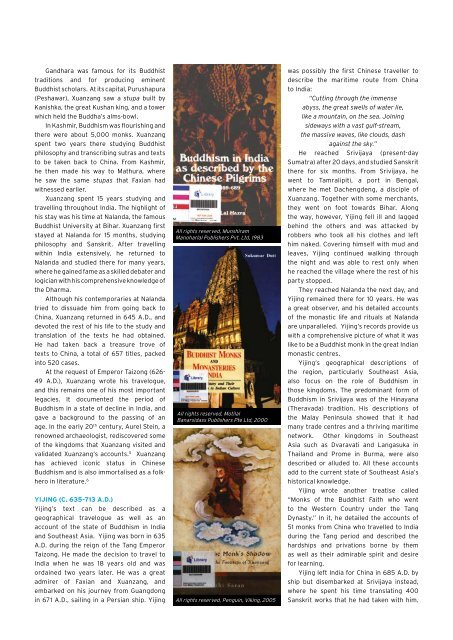éå°å¹³ä¸ æ°å å¡ç»éª - National Library Singapore
éå°å¹³ä¸ æ°å å¡ç»éª - National Library Singapore
éå°å¹³ä¸ æ°å å¡ç»éª - National Library Singapore
You also want an ePaper? Increase the reach of your titles
YUMPU automatically turns print PDFs into web optimized ePapers that Google loves.
Gandhara was famous for its Buddhist<br />
traditions and for producing eminent<br />
Buddhist scholars. At its capital, Purushapura<br />
(Peshawar), Xuanzang saw a stupa built by<br />
Kanishka, the great Kushan king, and a tower<br />
which held the Buddha’s alms-bowl.<br />
In Kashmir, Buddhism was flourishing and<br />
there were about 5,000 monks. Xuanzang<br />
spent two years there studying Buddhist<br />
philosophy and transcribing sutras and texts<br />
to be taken back to China. From Kashmir,<br />
he then made his way to Mathura, where<br />
he saw the same stupas that Faxian had<br />
witnessed earlier.<br />
Xuanzang spent 15 years studying and<br />
travelling throughout India. The highlight of<br />
his stay was his time at Nalanda, the famous<br />
Buddhist University at Bihar. Xuanzang first<br />
stayed at Nalanda for 15 months, studying<br />
philosophy and Sanskrit. After travelling<br />
within India extensively, he returned to<br />
Nalanda and studied there for many years,<br />
where he gained fame as a skilled debater and<br />
logician with his comprehensive knowledge of<br />
the Dharma.<br />
Although his contemporaries at Nalanda<br />
tried to dissuade him from going back to<br />
China, Xuanzang returned in 645 A.D., and<br />
devoted the rest of his life to the study and<br />
translation of the texts he had obtained.<br />
He had taken back a treasure trove of<br />
texts to China, a total of 657 titles, packed<br />
into 520 cases.<br />
At the request of Emperor Taizong (626-<br />
49 A.D.), Xuanzang wrote his travelogue,<br />
and this remains one of his most important<br />
legacies. It documented the period of<br />
Buddhism in a state of decline in India, and<br />
gave a background to the passing of an<br />
age. In the early 20 th century, Aurel Stein, a<br />
renowned archaeologist, rediscovered some<br />
of the kingdoms that Xuanzang visited and<br />
validated Xuanzang’s accounts. 5 Xuanzang<br />
has achieved iconic status in Chinese<br />
Buddhism and is also immortalised as a folkhero<br />
in literature. 6<br />
YIJING (c. 635-713 A.D.)<br />
Yijing’s text can be described as a<br />
geographical travelogue as well as an<br />
account of the state of Buddhism in India<br />
and Southeast Asia. Yijing was born in 635<br />
A.D. during the reign of the Tang Emperor<br />
Taizong. He made the decision to travel to<br />
India when he was 18 years old and was<br />
ordained two years later. He was a great<br />
admirer of Faxian and Xuanzang, and<br />
embarked on his journey from Guangdong<br />
in 671 A.D., sailing in a Persian ship. Yijing<br />
All rights reserved, Munshiram<br />
Manoharlal Publishers Pvt. Ltd, 1983<br />
All rights reserved, Motilal<br />
Banarsidass Publishers Pte Ltd, 2000<br />
All rights reserved, Penguin, Viking, 2005<br />
was possibly the first Chinese traveller to<br />
describe the maritime route from China<br />
to India:<br />
“Cutting through the immense<br />
abyss, the great swells of water lie,<br />
like a mountain, on the sea. Joining<br />
sideways with a vast gulf-stream,<br />
the massive waves, like clouds, dash<br />
against the sky.”<br />
He reached Srivijaya (present-day<br />
Sumatra) after 20 days, and studied Sanskrit<br />
there for six months. From Srivijaya, he<br />
went to Tamralipiti, a port in Bengal,<br />
where he met Dachengdeng, a disciple of<br />
Xuanzang. Together with some merchants,<br />
they went on foot towards Bihar. Along<br />
the way, however, Yijing fell ill and lagged<br />
behind the others and was attacked by<br />
robbers who took all his clothes and left<br />
him naked. Covering himself with mud and<br />
leaves, Yijing continued walking through<br />
the night and was able to rest only when<br />
he reached the village where the rest of his<br />
party stopped.<br />
They reached Nalanda the next day, and<br />
Yijing remained there for 10 years. He was<br />
a great observer, and his detailed accounts<br />
of the monastic life and rituals at Nalanda<br />
are unparalleled. Yijing’s records provide us<br />
with a comprehensive picture of what it was<br />
like to be a Buddhist monk in the great Indian<br />
monastic centres.<br />
Yijing’s geographical descriptions of<br />
the region, particularly Southeast Asia,<br />
also focus on the role of Buddhism in<br />
those kingdoms. The predominant form of<br />
Buddhism in Srivijaya was of the Hinayana<br />
(Theravada) tradition. His descriptions of<br />
the Malay Peninsula showed that it had<br />
many trade centres and a thriving maritime<br />
network. Other kingdoms in Southeast<br />
Asia such as Dvaravati and Langasuka in<br />
Thailand and Prome in Burma, were also<br />
described or alluded to. All these accounts<br />
add to the current state of Southeast Asia’s<br />
historical knowledge.<br />
Yijing wrote another treatise called<br />
“Monks of the Buddhist Faith who went<br />
to the Western Country under the Tang<br />
Dynasty.” In it, he detailed the accounts of<br />
51 monks from China who travelled to India<br />
during the Tang period and described the<br />
hardships and privations borne by them<br />
as well as their admirable spirit and desire<br />
for learning.<br />
Yijing left India for China in 685 A.D. by<br />
ship but disembarked at Srivijaya instead,<br />
where he spent his time translating 400<br />
Sanskrit works that he had taken with him.

















